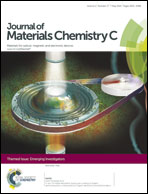Resistive switching dependence on atomic layer deposition parameters in HfO2-based memory devices†
Abstract
Resistance random access memory (ReRAM) is considered a promising candidate for the next generation of non-volatile memory. In this work, we fabricate Co/HfO2/Ti devices incorporating atomic-layer-deposited HfO2 thin films as the active material grown under different atomic layer deposition (ALD) conditions. We focus on analyzing the effect of ALD conditions on the resistive switching behaviour of the devices. Electrical characterization reveals a particular non-crossing current–voltage curve and bipolar resistive switching behaviour. Device memory properties were confirmed by stability and retention measurements as well as voltage pulses, by which logical computational processes were conducted. X-ray photoelectron spectroscopy combined with electrical measurements demonstrates that the presence of Hf sub-oxides at the interface with the underlying Ti layer is required in order to achieve a stable switching device. The ability of Ti to scavenge oxygen from the HfO2 is shown to be affected by the ALD conditions.

- This article is part of the themed collection: Emerging Investigators

 Please wait while we load your content...
Please wait while we load your content...